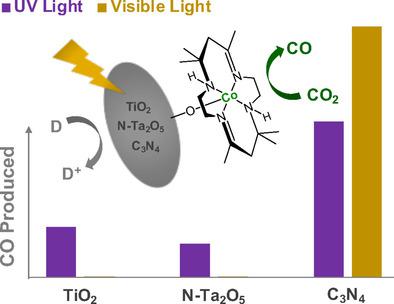当前位置:
X-MOL 学术
›
ChemPhotoChem
›
论文详情
Our official English website, www.x-mol.net, welcomes your
feedback! (Note: you will need to create a separate account there.)
Hybrid Carbon Dioxide Reduction Photocatalysts Consisting of Macrocyclic Cobalt(III) Complexes Deposited on Semiconductor Surfaces
ChemPhotoChem ( IF 3.0 ) Pub Date : 2020-03-04 , DOI: 10.1002/cptc.201900282 Peipei Huang 1 , Sebastian A. Pantovich 1 , Norbert O. Okolie 2 , N. Aaron Deskins 3 , Gonghu Li 1, 2
ChemPhotoChem ( IF 3.0 ) Pub Date : 2020-03-04 , DOI: 10.1002/cptc.201900282 Peipei Huang 1 , Sebastian A. Pantovich 1 , Norbert O. Okolie 2 , N. Aaron Deskins 3 , Gonghu Li 1, 2
Affiliation

|
Hybrid photocatalysts can be prepared by coupling metal‐ligand complexes with light‐harvesting semiconductors. It is often challenging and time consuming to derivatize ligands with anchoring groups to effectively attach onto surfaces. In this study, we synthesized hybrid carbon dioxide reduction photocatalysts by directly depositing two macrocyclic Co(III) complexes on three different semiconductor surfaces (TiO2, N−Ta2O5 and C3N4). The resulting hybrid photocatalysts were characterized with various techniques and tested in CO2 reduction reactions under different light conditions. Excellent visible‐light CO2‐reduction activity was obtained using C3N4 as the light‐harvesting semiconductor. Density functional theory calculations were conducted to help understand interactions between the cobalt complexes with a model TiO2 surface.
中文翻译:

沉积在半导体表面的大环钴(III)配合物组成的杂化二氧化碳还原光催化剂
杂化光催化剂可以通过将金属配体与光收集半导体结合而制得。具有锚定基团的配体衍生化以有效地附着在表面上通常是挑战性和耗时的。在这项研究中,我们通过在两个不同的半导体表面(TiO 2,N-Ta 2 O 5和C 3 N 4)上直接沉积两种大环Co(III)配合物来合成杂化二氧化碳还原光催化剂。所得的杂化光催化剂用各种技术表征,并在不同的光照条件下在CO 2还原反应中进行了测试。使用C获得了出色的可见光CO 2还原活性3 N 4作为光收集半导体。进行密度泛函理论计算以帮助理解钴配合物与模型TiO 2表面之间的相互作用。
更新日期:2020-03-04
中文翻译:

沉积在半导体表面的大环钴(III)配合物组成的杂化二氧化碳还原光催化剂
杂化光催化剂可以通过将金属配体与光收集半导体结合而制得。具有锚定基团的配体衍生化以有效地附着在表面上通常是挑战性和耗时的。在这项研究中,我们通过在两个不同的半导体表面(TiO 2,N-Ta 2 O 5和C 3 N 4)上直接沉积两种大环Co(III)配合物来合成杂化二氧化碳还原光催化剂。所得的杂化光催化剂用各种技术表征,并在不同的光照条件下在CO 2还原反应中进行了测试。使用C获得了出色的可见光CO 2还原活性3 N 4作为光收集半导体。进行密度泛函理论计算以帮助理解钴配合物与模型TiO 2表面之间的相互作用。











































 京公网安备 11010802027423号
京公网安备 11010802027423号